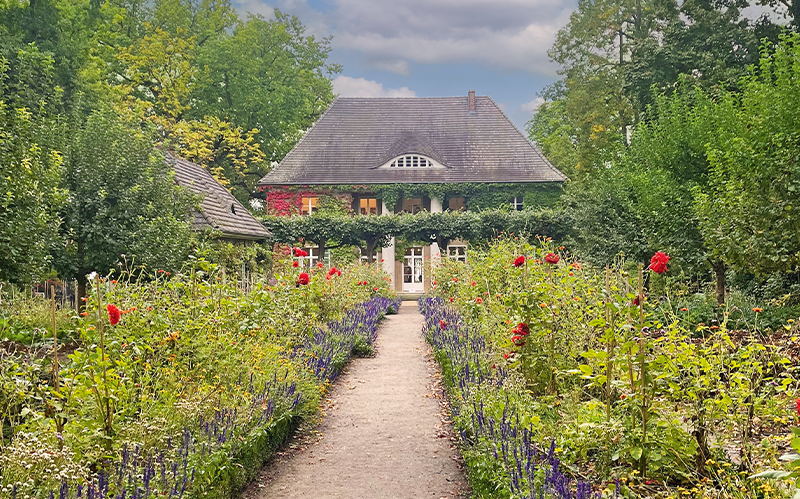
Nature has always been an important source of inspiration for artists. In this spring issue of Dorotheum’s myART MAGAZINE, Dorotheum specialists reveal their favourite gardens.
Joëlle Romba describes the garden of the Liebermann Villa on Lake Wannsee, in Berlin as one of the most beautiful in Germany. Dorotheum’s new Specialist for Modern and Contemporary Art in Berlin talks about the listed garden and the institution’s ambitious exhibition programme with Lucy Wasensteiner, Director of the Liebermann Villa.
“The Liebermann Villa at Wannsee has been a favourite destination for me and my family for years, partly because of its thought-pro- voking programme of exhibitions that explore Max Liebermann’s active period, with insight and from various perspectives,“ as said by Joëlle Romba. “The stunning garden is an inviting place for relaxation and leisure and the lush greenery really is a feast for the eyes. There is a lawn leading down to the lake with a birch-lined path; to the left of that are the vibrantly coloured flower beds and shrubs of the hedged gardens. Practical vegetable gardens were planted on the side of the house next to the road … it is a perfect picture of bucolic self-sufficiency.”
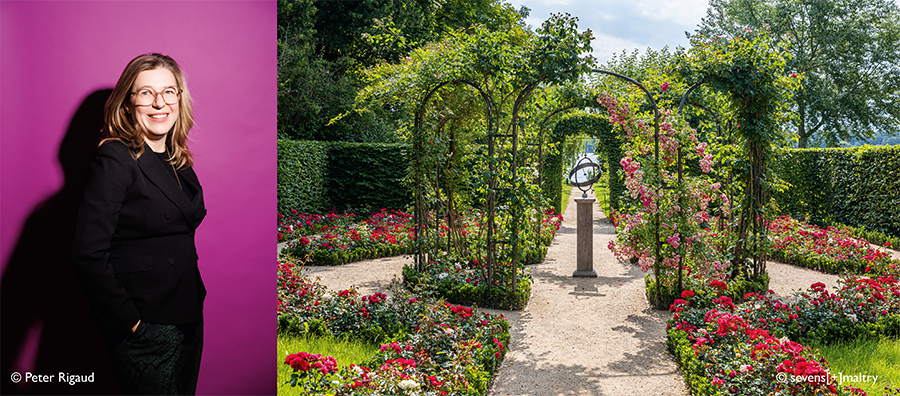
Joëlle Romba: Dr Wasensteiner, you were part of the curatorial team at the Liebermann Villa from 2015 to 2018, before taking over as Director in February 2020. My first encounter with your work as a curator was through the exhibition London 1938, which first opened at the Wiener Holocaust Library in London in 2018, before travelling to the Liebermann Villa, which at the time was under the direction of Martin Faass. How did this collaboration come about?
Lucy Wasensteiner: As part of my doctoral research, I studied the London exhibition entitled Twentieth Century German Art, which was held in 1938 as a direct response to the 1937 exhibition Entartete Kunst (Degenerate Art) in Munich. The London exhibition became the focus of my dissertation, and Liebermann of course featured prominently in it. I proposed the London 1938 project to the Liebermann Villa when I joined the team there in 2015. We were delighted to be able to work with the Wiener Library as our project partner in London, and the fact that we were eventually able to bring around 30 original works to the Liebermann Villa – including those from museums such as the Centre Pompidou in Paris, but also from institutions in Stockholm and London – was fantastic. Those were my first three years with Liebermann’s paintings. I returned to the Liebermann Villa in 2020 as it was looking for a new director.
The Liebermann Villa’s exhibition programme offers a diverse view not only of Max Liebermann’s oeuvre, but also of the cultural milieu of the 1920s. You recently staged an interesting exhibition on the now largely forgotten modernist art dealer Grete Ring, for example; Ring, together with Walter Feilchenfeldt, played a key role in the continuation of Kunstsalon Cassirer, Max Liebermann’s main gallery, after the death of Paul Cassirer.
Max Liebermann is really such an interesting subject. He was so influential in his time and was in contact with so many people. So, what we have here is an incredible network that we can shine a light on, through the Liebermann connection. And if doing so means uncovering untold stories, so much the better. Of course, many of these more obscure stories are about the women who formed an integral part of Liebermann’s circle: female artists, photographers, art dealers and so on. Grete Ring was an ideal subject for us in this respect. We have also tried to draw a contemporary connection in recent years. Liebermann was an enthusiastic supporter of young artists.
He was also the President of the Prussian Academy of Arts, so it fell within his purview …
And he was also very interested in what young people thought of his art. We came across a 1905 quote from Liebermann where he writes: “He who holds the youth holds the future, and that is the only thing that matters.” We decided to revisit that idea and, between 2022 and 2023, invited a painting class at the Berlin University of the Arts to create new works inspired by Liebermann’s art, his story, and his villa. The resulting artworks were then shown all over the villa grounds in the summer of 2023: in the exhibition spaces alongside Liebermann’s paintings, but also in the garden. Artworks were everywhere, from the front garden to Lake Wannsee. Performances took place in the garden. It was very exciting to see.
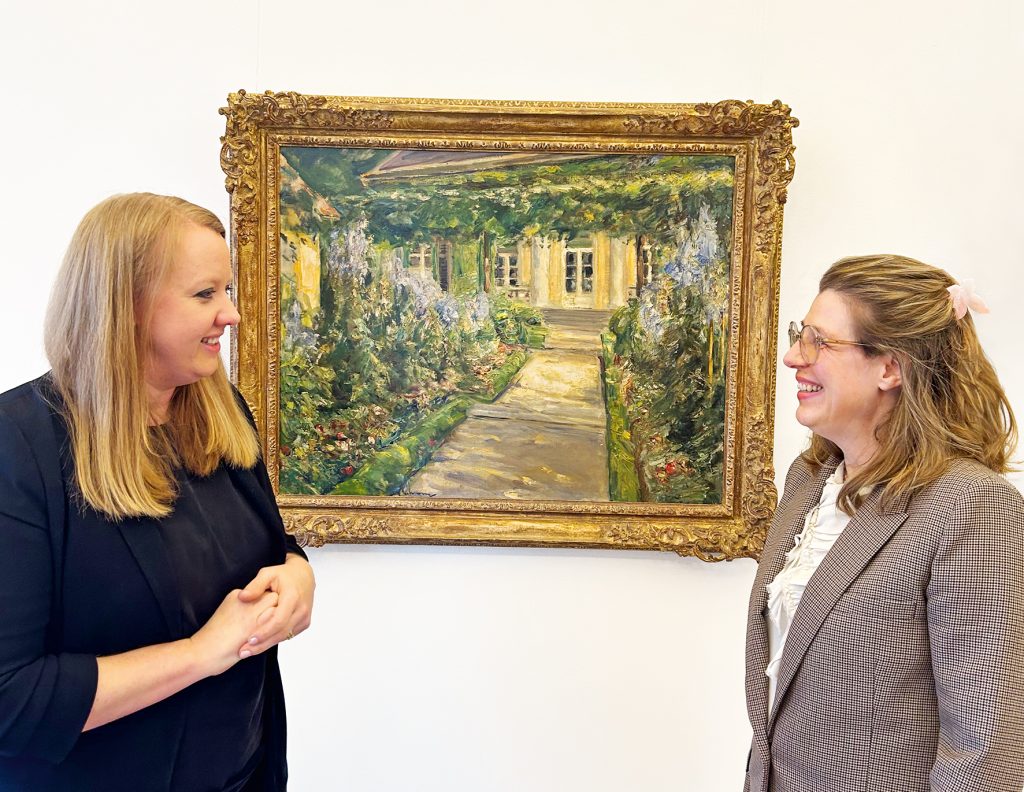
Can you tell us more about the history of the villa? I understand it was the summer residence of the Liebermann family.
The “Alsen villa colony”, which catered to Berlin’s haute bourgeoisie, had been here on the banks of Wannsee since 1863. Liebermann was one of the last purchasers to secure land here on the lakeside in 1909 – two plots – setting the stage for the construction of his summer residence between 1909 and 1910. It was important for Liebermann to be involved in the design of both the house and the garden. His friend Alfred Lichtwark gave him much support and assistance in designing the garden. Lichtwark, then Director of Hamburger Kunsthalle, was a proponent of the so-called “reform garden movement”: in contrast to the English garden, which essentially imitates nature, the “reform garden” is clearly man-made and amenable to modern life, with clear lines and defined areas. The garden, conceived as a functional space, included a kitchen garden for growing fruit and vegetables and a well-tended lawn for leisure. Colour was to be used in a very targeted, specific way that deliberately deviated from nature. As in: only red over here, or only yellow and purple over there …
… a composition, the kind of which you would see in modern art. The garden was recreated to reflect Liebermann and Lichtwark’s original designs.
True, there were plans drawn up by landscape architect Albert Brodersen, but what really throws light on the planning process are the numerous, very detailed letters exchanged between Liebermann and Lichtwark. The villa was also extensively photographed during Liebermann’s lifetime. Apart from press photographs, we have over 200 oil paintings showing the garden from all angles. These, together with photographs from the period, allow us to see which colours were used where.
When did the garden become an inspiration for Liebermann’s art?
Liebermann’s main source of inspiration from the 1870s onwards was Holland, which he visited every year. It wasn’t until the outbreak of the First World War in 1914, and the resulting restrictions on travel that he realised, as he said “I have a fantastic subject right here.” He began to spend a lot of time painting in the garden. It was also around that same time that he developed his Impressionist style, using a technique that he had developed in the late 19th century. The paintings he created here at Wannsee are really Liebermann’s major Impressionist works.
Could you perhaps give us a little glimpse of the future: what is next for the Liebermann Villa in the near term?
In May we are opening a very interesting exhibition on Liebermann’s connections with Italy, including loans from the Uffizi which collected his work early on. We will have another exhibition towards the end of the year about Dora Hitz, co-founder of the Berlin Secession, with her first solo exhibition in a century. And looking ahead to 2025, we will be turning our attention to collectors Carl and Felicie Bernstein, amongst others. I’d like to explore the Liebermann topic more broadly, always with an eye to keeping the institution relevant – to Liebermann connoisseurs and all Berliners, but also to an international audience.
A remarkable programme! Especially when you consider that you do it all without any basic government funding.
Absolutely, we operate without any primary funding from the government and live mainly from our entrance fees. That’s why we’re so happy about every visitor who makes it out to see us here at Wannsee. We also have around 2,300 supporting members and about 120 volunteers who help out as guides, in the shop or in the garden. So, as you can see, the Liebermann Villa really is a team effort.
Lucy Wasensteiner in conversation with Joëlle Romba
Dorotheum’s tortoise garden
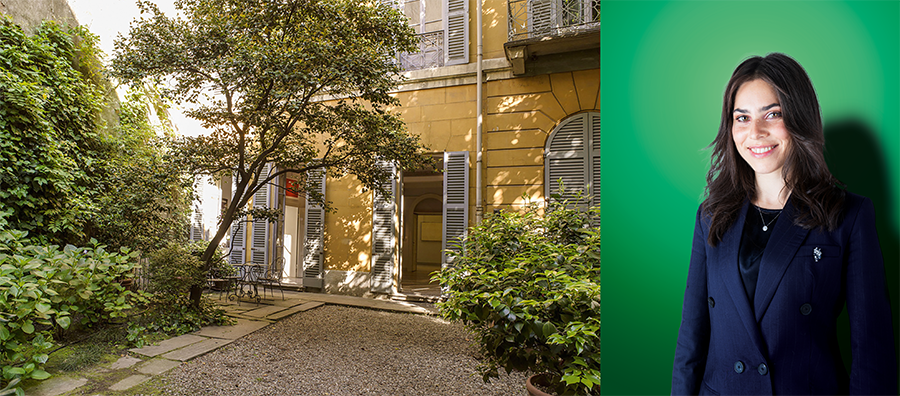
For South Tyroleans or people from Trentino who, like me, grew up at the foot of the majestic Rosengarten or Catinaccio group in the Dolomites, there is no garden more fascinating than King Laurin’s Rose Garden, the setting of Karl Felix Wolff ’s compelling Ladin legends. Arriving at Dorotheum’s Milan branch a few weeks ago, I imagined I would find rooms full of remarkable artworks, but was taken by surprise to discover a garden whose beauty would get me reminiscing about King Laurin’s Rosengarten.
Private gardens are rare in Milan, and of those populated by curious animals, only the one at Villa Invernizzi is known. Beautiful pink flamingos splash in its pool, so much so that it has become one of the city’s tourist attractions. Yet there is another garden that is home to some unexpected animals – that of Dorotheum at Palazzo Amman. Its residents include two ancient tortoises which occasionally try to invade our specialists’ offices to admire some artwork, or try on jewellery or watches. I have to say, they are wonderful colleagues to work with!
Giulia Pastore
Natural Wildness
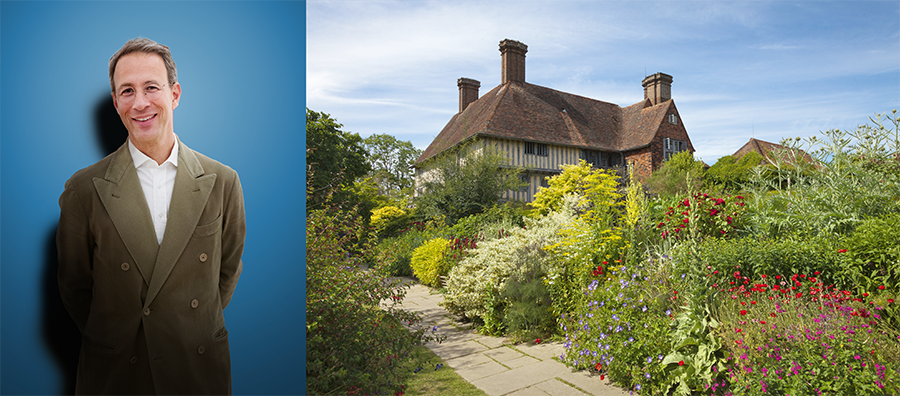
During the 20 years I lived in London, trips to the wonderful gardens of England were always a welcome distraction from the fast-paced city life. Located in East Sussex, less than 20 kilometres from the English Channel, Great Dixter Gardens were always one of my favourites. Its current form was designed by Christopher Lloyd around his parents’ home, an ensemble composed of two medieval buildings and a new wing by Edwin Lutyens in the Arts and Crafts style from around 1910. Lloyd was a master of simultaneously directing and taming the lush greenery, while still allowing it to grow spontaneously. This created a natural wildness in the flower beds which stands in stark contrast to the time-honoured yew trees in the shape of peacocks planted by his father. For me, Great Dixter is the ideal garden par excellence: lush greenery all year round, a varied design with native and exotic plants, sustainable fruit, herb and vegetable cultivation, and an orchard that can grow wild beyond the paths.
Bernhard Brandstätter

